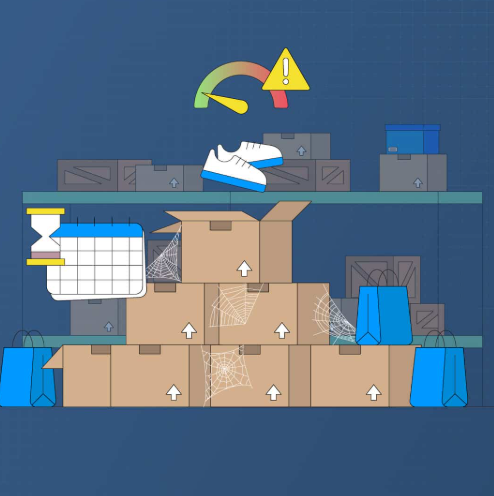In the world of retail, managing stock effectively is essential for maintaining a smooth operation. Dead stock and excess inventory are common challenges that can significantly impact a business’s bottom line. While excess inventory refers to products that take up space in your warehouse without generating revenue, dead stock refers specifically to items that remain unsold and no longer have value.
Understanding how to manage these two types of inventory is critical for optimizing operations and maximizing profitability. In this article, we’ll dive into the concept of dead stock, how to prevent it, and effective strategies for managing excess inventory.
What is Dead Stock and Why Does It Matter?
Dead stock refers to products that haven’t sold and are occupying valuable storage space. This can lead to a series of financial challenges, including wasted resources and lost potential revenue. Retailers often use inventory management software to track product movement, which helps identify slow-moving products and avoid overstocking.
The Common Causes of Dead Stock
Identifying the root causes of dead stock is essential for preventing it. Some of the most common causes include:
1. Over-ordering
Retailers can avoid over-ordering by purchasing smaller quantities more frequently. This method allows for more accurate forecasting, preventing the accumulation of unsold products.
2. Inaccurate Demand Forecasting
Accurate demand forecasting relies on analyzing historical sales data and market trends. By studying past performance, retailers can avoid ordering products that may not have strong market demand.
3. Poor Sales or Marketing Efforts
Sometimes, high-quality products don’t sell because of poor marketing or insufficient customer awareness. Retailers should ensure effective marketing strategies and solid communication between sales and marketing teams to boost product visibility and drive sales.
Dead Stock vs. Excess Inventory: What’s the Difference?
While dead stock specifically refers to unsold items that are no longer viable, excess inventory consists of products that haven’t sold yet but may eventually do so. It’s crucial to distinguish between the two, as they require different strategies for management. Through regular inventory analysis, retailers can better assess which items fall into each category and take the necessary actions.
How Dead Stock Develops
Dead stock usually develops when there is a lack of visibility into inventory levels or when an overly large product catalog dilutes sales across multiple items. Here’s how:
1. Lack of Inventory Visibility
Without an efficient inventory management system, products can easily be forgotten or overlooked, leading to unsold stock sitting idle in storage.
2. Overly Large Product Catalogs
Expanding a product catalog based on intuition, rather than data analysis, can lead to an influx of products that don’t meet customer demand. It’s important to make data-driven decisions when introducing new products to avoid excess stock.
Why Dead Stock is Bad for Your Business
Dead stock can have several negative consequences, including:
1. Tied-Up Capital
Unsold inventory locks up capital that could otherwise be used for new investments or business growth. The longer products sit in storage, the more costly it becomes to keep them.
2. Increased Storage Fees
Dead stock takes up valuable warehouse space. As inventory accumulates, so do storage costs. These ongoing fees can add up quickly, especially if dead stock remains unsold for extended periods.
3. Opportunity Cost
The money spent on dead stock could have been better invested elsewhere in the business, potentially generating a better return.
How to Calculate the Cost of Dead Stock
While calculating the cost of dead stock can be tricky, it’s essential for understanding its financial impact. There are a few ways to estimate the cost:
1. Dead Stock Value
Multiply the quantity of each unsold item by its unit price. The total value of the dead stock is the estimated financial loss.
2. Dead Stock Sunk Cost
This includes all the direct costs of producing and acquiring the dead stock, such as raw materials and labor, which have already been spent.
3. Dead Stock Opportunity Cost
Consider the missed revenue from unsold products. This represents the potential profit that could have been generated if the products had sold as expected.
3 Key Strategies for Preventing Dead Stock
Proactively preventing dead stock is more effective than trying to deal with it after it’s accumulated. Here are three strategies to minimize dead stock:
1. Use an Effective Inventory Management System
An advanced inventory management system helps track inventory levels in real-time, providing insights into sales trends and demand. This data enables retailers to make informed decisions about what to order and when to reorder, avoiding overstocking.
2. Limit Initial Product Orders
Rather than placing large orders for new products, retailers should test the market with smaller quantities first. This allows them to gauge customer interest and avoid committing to large quantities of stock before it’s clear whether it will sell.
3. Listen to Your Customers
Engaging with customers through surveys, social media, and reviews can provide valuable insights into what products they are interested in. Understanding customer preferences can guide product selection and reduce the risk of unsold stock.
How to Prevent Dead Stock From Accumulating
In addition to managing existing stock, retailers can take steps to prevent dead stock from accumulating in the first place:
1. Conduct Thorough Market Research
Before making large product orders, retailers should gather data about market trends, customer preferences, and expected demand. This ensures that products align with customer needs, reducing the likelihood of overstocking.
2. Regularly Monitor Inventory and Sales
Keep track of inventory levels and sales data. By reviewing performance regularly, retailers can adjust their orders to match current demand, minimizing the risk of dead stock.
3. Improve the Returns and Exchange Process
A slow or inefficient returns process can contribute to dead stock. Products returned by customers need to be processed quickly and restocked or remarketed to avoid them becoming dead stock. Efficiently managing returns helps prevent lost sales and reduces inventory buildup.
Conclusion
Effectively managing dead stock and excess inventory is crucial for maintaining a profitable retail business. By implementing a reliable inventory management system, regularly analyzing sales data, and engaging with customers, retailers can avoid the financial pitfalls of unsold stock. Proactive strategies, such as limiting initial product runs and forecasting demand accurately, are essential to maintaining a smooth and efficient operation.
With the right tools and strategies, businesses can optimize their inventory, reduce waste, and ensure that capital is invested in products that contribute to growth and profitability.



